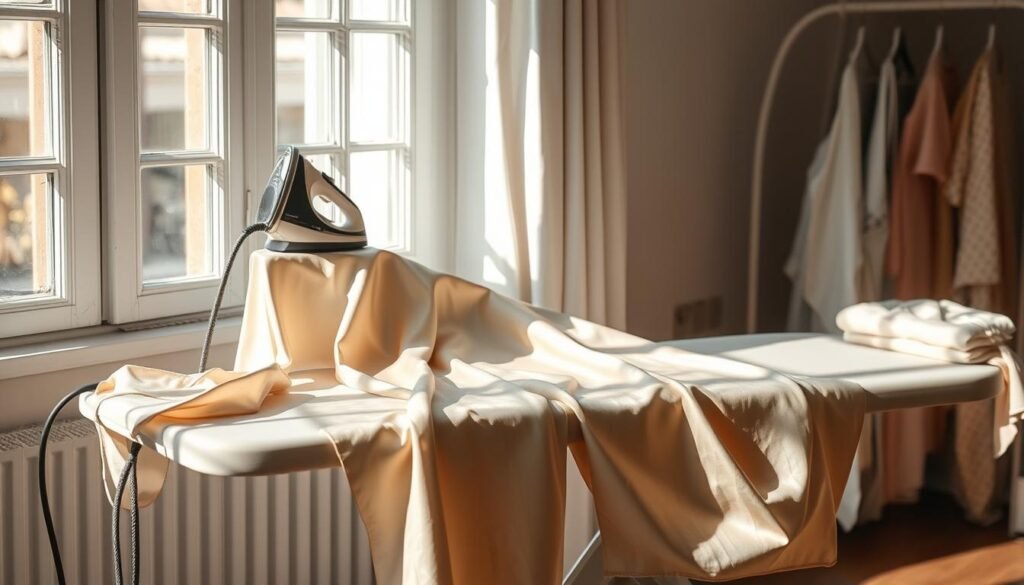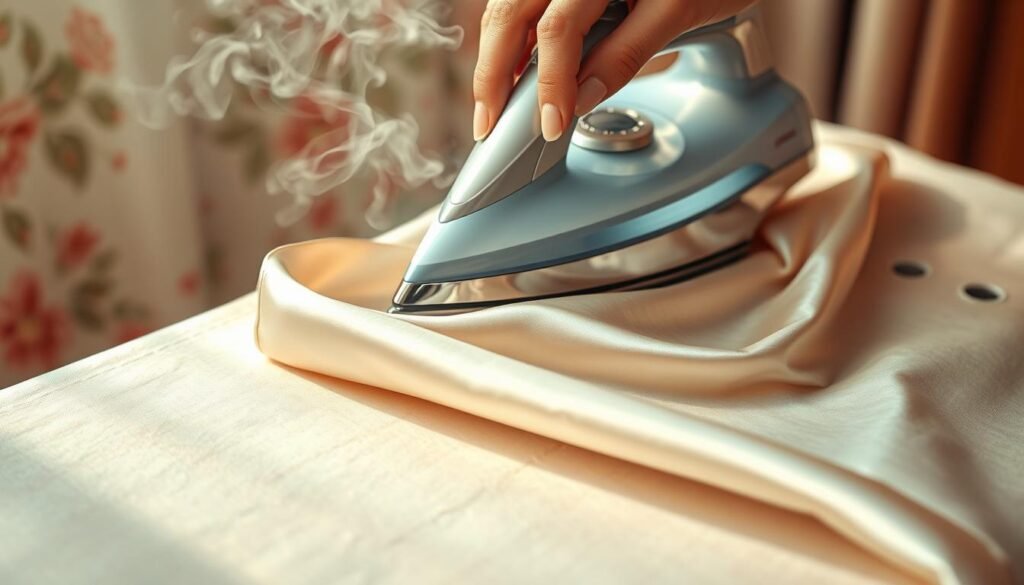Are you scared to iron your fancy silk clothes? Silk’s delicate nature makes ironing seem tough. But, with the right steps, you can get rid of wrinkles and keep the silk looking great. Learn how to iron silk without harming it.
Key Takeaways
- Silk is a delicate protein-based fiber that is susceptible to wrinkling1
- Proper iron temperature setting and technique are crucial to prevent silk damage
- Avoid steam ironing and use a press cloth to protect the silk surface
- Iron silk while slightly damp and use gentle, one-directional motions
- Finish with a cool-down period to help the silk retain its shape and luster
Understanding the Nature of Silk
Silk comes from silkworm cocoons2. It has a special structure that makes it shiny and soft3. But, it can be damaged by heat, moisture, and rough handling.
Silk: A Delicate Protein Fiber
Silk is strong, but it gets weaker when wet3. It doesn’t stretch much, unlike other fabrics3. So, silk clothes like shirts need careful handling to keep their shape.
The Importance of Gentle Care
It’s key to take good care of silk to keep it looking great2. Washing silk wrong can harm it, making it lose its shine and feel3. Always follow the care label to keep silk in top shape3.
Silk clothes are more delicate than silk sheets3. Never wring them out, as it can break the fibers3. And never use bleach, as it damages the silk3.
Knowing how to care for silk helps it stay beautiful and last longer2. Gentle handling is key to keeping silk looking great.
Choosing a trusted silk maker like Tianruiyi is important2. They know how to make sure your silk stays beautiful and lasts a long time.
“Silk is a captivating natural fiber, derived from the cocoons of silkworms. This delicate protein fiber possesses a unique molecular structure that gives it a lustrous sheen and a smooth, soft hand feel.”
| Silk Fabric Properties | Silk Fiber Characteristics |
|---|---|
| Strength | Strongest natural fabric, but loses strength when wet |
| Elasticity | Moderate to poor elasticity compared to other textiles |
| Delicacy | Lighter weight silk clothes are more fragile to handle |
| Care Requirements | Requires gentle handling and specialized washing/drying methods |
Preparing Your Iron
Before ironing your silk clothes, make sure your iron is ready. The right temperature and a clean iron are key to keeping your silk looking great4.
Choosing the Correct Iron Setting
Silk is very delicate and can burn easily if the heat is too high4. Set your iron to the lowest heat, usually around 300°F4. Many irons have a special “silk” setting for this delicate fabric4.
Cleaning Your Iron
It’s important to clean your iron before ironing silk4. Any leftover residue can damage your silk. Clean your iron well before starting4.
| Ironing Silk: Key Considerations | Percentage |
|---|---|
| Silk items recommended for dry cleaning only | 5 |
| Silk scarves that may not tolerate ironing well | 5 |
| Temperature for the ‘silk’ setting on irons | 5 |
| Individuals who use a pressing cloth while ironing silk | 5 |
| Individuals who iron silk scarves on the reverse side | 5 |
| Individuals who avoid using the steam function when ironing silk | 5 |
| Ratio of individuals who iron silk scarves in sections for larger scarves | 5 |
| Individuals who test the iron on a small area before ironing the whole silk scarf | 5 |
Make sure your iron is at the right temperature and clean. This will help you get your silk clothes wrinkle-free and looking great6.
Setting Up Your Ironing Surface
Ironing silk needs the right setup for smooth results. Use a clean, flat, and heat-safe surface. An ironing board with a fresh cover is best7. Or, a hard, clean table works too, but it must be spotless8.
Using an Ironing Board
An ironing board is great for silk. It’s adjustable and sturdy, making ironing easy. Make sure the board is covered with a clean, quality cover that won’t burn or mark the silk.
Protecting Your Silk with a Press Cloth
Use a clean white cloth or press cloth under the silk. It protects the silk from the iron, preventing stains or burns8. This is key if you’re using a new iron or surface to keep the silk safe.

“Ironing silk on a clean, flat, heat-resistant surface with a press cloth is the key to keeping your silk fabrics wrinkle-free and in pristine condition.”
| Ironing Surface | Recommended Temperature |
|---|---|
| Silk | Approximately 300°F7 |
| Synthetic Fabrics (Acetate, Polyester) | Around 275°F7 |
| Cotton and Linen | 400°F or more7 |
Right ironing setup and a press cloth keep silk looking great. They help avoid wrinkles and damage789.
How to Iron Silk Fabric: Care Tips for Wrinkle-Free Silk
Ironing silk fabrics needs a gentle touch and careful steps. The silk ironing process has key steps to keep your silk looking great. This includes garments, sheets, and accessories.
Start by ironing silk when it’s a bit damp. This makes the fabric easier to iron and gets rid of wrinkles well10. Also, iron silk with the inside out to protect the outer layer10.
When ironing silk garments, use soft pressing motions, not back-and-forth ones10. This helps avoid damage. Start with the sleeves and move to the collar and hem. Be careful not to burn the silk11.
- Use the lowest iron temperature and slowly increase it if needed10.
- Think about using a steam iron or fabric steaming wand for smooth wrinkles. But, don’t use too much steam to avoid water spots10.
- After ironing, hang your silk on padded or wooden hangers to cool and keep their shape11.
By following these steps to iron silk, you can keep your silk looking great. This way, you avoid wrinkles1011.
“The secret to keeping silk garments wrinkle-free lies in the delicate balance of heat, moisture, and handling.”
Iron While Slightly Damp
Ironing silk needs the right timing. It’s best to iron when the fabric is a bit damp, not dry12. Spritzing the silk with water helps prevent burning the delicate fibers12. This makes the fabric easier to iron, leaving it smooth and wrinkle-free.
Let the silk hang until it’s almost dry after washing. Don’t wring it out to avoid harming the fibers12. Using a press cloth between the iron and silk protects the fabric from heat12.
Keep the iron low when ironing silk12. High heat can make the silk yellow or damage it12. Don’t iron in one spot for too long, as it can harm the fabric12. Instead, lift the iron and let the fabric cool between sections12.
If you won’t use the silk right away, hang it in a cool, dry, dark spot12. Use mothballs to keep pests away12. Always check the care label before ironing to follow the maker’s instructions12.
For those who don’t like ironing, steam can help smooth out silk clothes like blouses and jackets13. Hanging silk in the bathroom during a hot shower can also get rid of wrinkles without ironing1312.
Iron the Wrong Side
Ironing silk? Always turn the fabric inside out and iron the “wrong” side14. This keeps the shiny side safe from the hot iron. It stops scorching and keeps the silk looking new14.
Many silk lovers iron on the wrong side and it works great14. 1 out of every 3 silk users don’t do this, which can harm the silk’s shine14. Make it a rule to iron silk inside out to keep it looking good.
When ironing silk, pick the right heat15. Silk can burn easily, so high heat is bad15. Use a temperature of about 300°F, which is what modern irons suggest for silk15. Ironing the wrong side at this heat keeps silk smooth and safe.
The secret to ironing silk well is to be gentle and quick15. Don’t go back and forth. Use quick presses to smooth the silk15. This way, you get a smooth, professional look every time.
Follow these easy steps to iron silk with confidence. Your silk will stay luxurious and look great1415.
Ironing Technique: Quick and Gentle
Ironing silk needs a quick and gentle touch. Don’t use back-and-forth motions as they can burn and damage the fabric16. Use pressing motions instead, moving the iron smoothly over the silk16.
Avoid Back-and-Forth Motions
Keep your silk ironing smooth by avoiding harsh moves16. Back-and-forth strokes can harm the silk’s shine16. Keep a steady, gentle pace to get rid of wrinkles.
Use Pressing Motions for Garments
For silk clothes like shirts or blouses, pressing works best16. Use short, light strokes to let the iron move smoothly over the silk16. This removes wrinkles without harming the silk.
Learning quick and gentle ironing keeps your silk looking great. Discover custom silk’s perks and how to keep them smooth with this method.

“Ironing silk requires a delicate touch and a thoughtful approach to preserve its natural luster and prevent any damage.”
| Fabric | Recommended Iron Temperature |
|---|---|
| Silk | 300°F |
| Polyester | 275°F |
| Cotton and Linen | 400°F or more |
Avoid Steam Ironing
When ironing silk, don’t use a steam iron. Steam can leave water stains and spots on the delicate silk. This can ruin its look and feel18. Stick to a dry iron setting for silk to keep it looking great.
Most irons have special settings for different fabrics, like silk, which is usually around 300°F18. Synthetic fabrics like acetate or polyester need about 275°F18. Cotton and linen need even higher temperatures, over 400°F18. Using the right iron setting for silk helps get a smooth finish without water damage.
If you must use a steam iron on silk, cover the fabric with a press cloth18. Also, iron on a clean surface to prevent stains. Cleaning your iron is easy and keeps it working well18.
Iron silk when it’s a bit damp, but avoid wringing out too much water to prevent damage18. A fabric steaming wand is a better choice for delicate silk items18.
Be gentle when ironing silk and don’t move the iron back and forth to avoid scorch marks18. Start with low heat and increase it if needed, don’t start high18.
Ironing is a top way to get rid of wrinkles in silk19. It’s quick and easy to use an iron for this19. Steaming silk is also good for removing wrinkles if you don’t have an iron19. Or, take your silk to dry cleaners for a wrinkle-free look19. Even hot shower water can steam silk well, taking just 15 minutes19.
Follow these tips and skip steam irons to keep your silk looking great. With care, you can enjoy silk’s luxury and keep it looking new.
Start Low and Increase Heat Gradually
When ironing silk, start with the lowest heat setting on your iron. Then, increase the heat slowly as needed20. Delicate silks need ironing at low heat without steam to avoid damage21. Silk doesn’t wrinkle much, so you can use a special silk setting on your iron21. Iron silk items on the lowest heat setting to avoid shrinkage from too much water or heat.
Be very careful when ironing silk because it can easily burn from too much heat20. You’ll need strong ironing tools like a board, adjustable iron, spray bottle, pressing cloth, timer, and distilled water21. To get rid of wrinkles, hang silk items in a steamy bathroom or use a cool hairdryer on them21. Steaming or spraying wrinkled areas with water can also help smooth them out.
Always start with low heat and slowly increase it to avoid damaging the silk.2021 Ironing regularly helps keep clothes looking good longer. It’s a good idea to use a towel, cloth, or T-shirt to protect the silk while ironing.
“Proper ironing techniques for satin garments involve starting from the top, being cautious around delicate areas, and hanging the garment after ironing to prevent creases.”22
Steaming: An Alternative to Ironing
Steaming is a gentler way to remove wrinkles from silk23. Silk is delicate and needs care to avoid heat damage. It’s made of protein-based fibers that can burn easily under high heat23. Using vertical steaming or garment steamers can refresh silk without the risk of a hot iron.
Vertical Steaming for Garments
Hang silk clothes vertically and steam them to smooth out wrinkles24. This method uses gravity to relax the fabric and remove wrinkles over time24. It takes longer but keeps your silk safe and feeling luxurious.
Garment Steamers for Delicate Fabrics
Garment steamers are great for delicate fabrics like silk24. They use steam to get rid of wrinkles without direct contact or high heat24. Many irons also have silk settings around 300°F to protect the fabric23.
Steaming is a good way to keep silk looking great without harming it24. You can choose vertical steaming or a garment steamer for wrinkle-free silk24.
| Fabric | Optimal Ironing Temperature |
|---|---|
| Silk | Around 300°F |
| Cotton and Linen | 400°F or more |
“Silk should ideally not be exposed to heat in any form, whether wet or dry.”
Conclusion
Follow the right steps and be careful to keep silk looking great and safe25. Use the lowest heat, iron the back side, and skip steam to keep silk items looking new25. This way, you can enjoy silk’s beauty without wrinkles25.
Use special care tips like handwashing and gentle ironing to keep silk looking good for a long time25. Many think silk is hard to care for, but this guide shows easy ways to keep it wrinkle-free and perfect25.
This article sums up how to iron silk without wrinkles2627. With the right steps and careful attention, your silk will stay beautiful and last longer25.
FAQ
What is the ideal iron temperature for ironing silk?
Iron silk at the lowest heat setting, about 300°F. Always check your iron’s fabric settings and test on a hidden spot first. This ensures the silk won’t get scorch marks.
How should I prepare the ironing surface for silk?
Iron silk on a clean, flat surface. Use an ironing board with a clean cover or a hard, heat-resistant table. For extra safety, put a clean white cloth or press cloth between the silk and the ironing surface.
Should I iron silk when it’s dry or damp?
Iron silk when it’s a bit damp, not fully dry. Hang your silk items to almost dry after washing. Don’t wring them out to avoid fiber damage.
Which side of the silk fabric should I iron?
Iron the silk’s inside out. This keeps the shiny side safe from the iron’s heat. It prevents scorch marks and damage to the sheen.
What ironing technique should I use for silk?
Iron silk with a quick, gentle touch. Don’t use back-and-forth motions that can scorch it. Instead, use pressing motions for a smooth finish. For garments, use pressing techniques over long strokes.
Should I use a steam iron on silk?
No, avoid steam irons on silk. Steam can leave water stains and spots, ruining the silk’s look and feel. Use a dry iron setting to keep silk looking great.
Is there an alternative to ironing silk?
Yes, steaming is a gentler option for silk. Hang silk items vertically and steam them to smooth out wrinkles. Use garment steamers made for delicate fabrics to refresh silk without heat damage.




